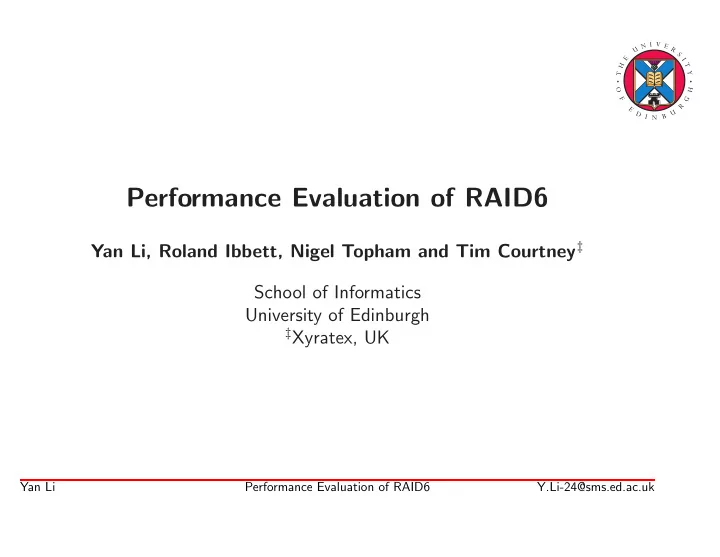

V I N E U R S E I H T Y T O H F G R E U D B I N Performance Evaluation of RAID6 Yan Li, Roland Ibbett, Nigel Topham and Tim Courtney ‡ School of Informatics University of Edinburgh ‡ Xyratex, UK Yan Li Performance Evaluation of RAID6 Y.Li-24@sms.ed.ac.uk
V I N E U R S E I H T Y T Project Motivation 1 O H F G R E U D B I N Project Motivation • Increasing the number of disks results in higher disk failure possibility. • The larger disk capacity leads to a longer rebuilding time, resulting higher bit error possibility during the reconstruction. • The end-of-life issue. • Double disk failure protection scheme RAID6 is becoming more and more necessary. Yan Li Performance Evaluation of RAID6 Y.Li-24@sms.ed.ac.uk
V I N E U R S E I H T Y T Project Motivation 2 O H F G R E U D B I N Reliability of systems over 5 years old 5 7 x 10 x 10 3.5 MTTF of RAID systems (Hours) MTTFof RAID systems (Hours) RAID5 RAID6 RAID5 3 6 2.5 4 2 2 1.5 1 0 80 100 120 140 160 180 200 80 100 120 140 160 180 200 number of disks number of disks −4 x 10 0.07 3 RAID5 RAID6 annual system failure rate annual system failure rate 0.06 2.5 0.05 2 0.04 1.5 0.03 0.02 1 80 100 120 140 80 100 120 140 number of disks numbre of disks MTTF of disks = 1000,000/30, MTTR = 8 hours Yan Li Performance Evaluation of RAID6 Y.Li-24@sms.ed.ac.uk
V I N E U R S E I H T Y T Project Motivation 3 O H F G R E U D B I N Project Goal • Evaluate the performance of RAID6 under the SPC Benchmark-1 (SPC-1) workload through simulation and explore the design space. – The performance of RAID6 under fault-free operation. – The performance of degraded mode. – Find out how to allocate resources between rebuilding and serving of incoming requests during the rebuilding stage so that it needs the shortest time for the system to return to normal operation mode Yan Li Performance Evaluation of RAID6 Y.Li-24@sms.ed.ac.uk
V I N E U R S E I H T Y T Performance of RAID6 4 O H F G R E U D B I N Performance of RAID6 • We focus on the RAID6 algorithms that store the redundant information separately from the data in each stripe, like Read-Solomon, EVENODD and RDP. 8+P+Q data layout is used. • Effect of RAID controller processing time. • Optimum size of the stripe unit under SPC-1 workload • The effect of increasing cache size and number of disks and their interactive effects. Yan Li Performance Evaluation of RAID6 Y.Li-24@sms.ed.ac.uk
V I N E U R S E I H T Y T Simulation Results 5 O H F G R E U D B I N Effect of RAID controller processing time 60 28Disks 14Disks 55 Max SPC−1 BSU for 30ms response 50 45 40 35 30 25 0 50 100 150 200 250 300 350 Controller Processing Time (us) Yan Li Performance Evaluation of RAID6 Y.Li-24@sms.ed.ac.uk
V I N E U R S E I H T Y T Simulation Results 6 O H F G R E U D B I N Optimum Size of Stripe Unit without Cache Yan Li Performance Evaluation of RAID6 Y.Li-24@sms.ed.ac.uk
V I N E U R S E I H T Y T Simulation Results 7 O H F G R E U D B I N Optimum Size of Stripe Unit with Cache Yan Li Performance Evaluation of RAID6 Y.Li-24@sms.ed.ac.uk
V I N E U R S E I H T Y T Simulation Results 8 O H F G R E U D B I N Effect of Cache Size 90 1 RAID5 RAID6 80 0.95 RAID5 RAID6 Max SPC−1 BSU for 30ms response 70 0.9 read miss rate 60 0.85 50 0.8 40 0.75 30 0.7 20 0.65 0 0.2 0.4 0.6 0.8 1 0 0.2 0.4 0.6 0.8 1 cache size/total ASU capacity (%) cache size/total ASU capacity Yan Li Performance Evaluation of RAID6 Y.Li-24@sms.ed.ac.uk
V I N E U R S E I H T Y T Performance of RAID6 9 O H F G R E U D B I N Summary • The achievable maximum SPC-1 BSU number of RAID6 is mainly decide by the disk array. The controller processing time has little effect on that. • Among the tested value (4, 8, 16, 32, 64 kBytes), the optimum size of stripe unit for RAID6 without cache is 16 KBytes; and that of RAID6 system with cache is 32 KBytes. This is irrelevant to the number of disks in the system. • With cache that is 0 . 12% of the total asu capacity, there is about 100% increase on the performance. • With the same size of cache and asu capacity, the performance of RAID6 is about 70% of RAID5 under SPC-1 workload. Yan Li Performance Evaluation of RAID6 Y.Li-24@sms.ed.ac.uk
V I N E U R S E I H T Y T Future Work 10 O H F G R E U D B I N Future Work • Test the effect of controller processing time with larger disk arrays • Study the performance of RAID6 under degraded mode. • The performance of RAID6 under other workload. • Investigate the best recovering scheme. Yan Li Performance Evaluation of RAID6 Y.Li-24@sms.ed.ac.uk
Recommend
More recommend